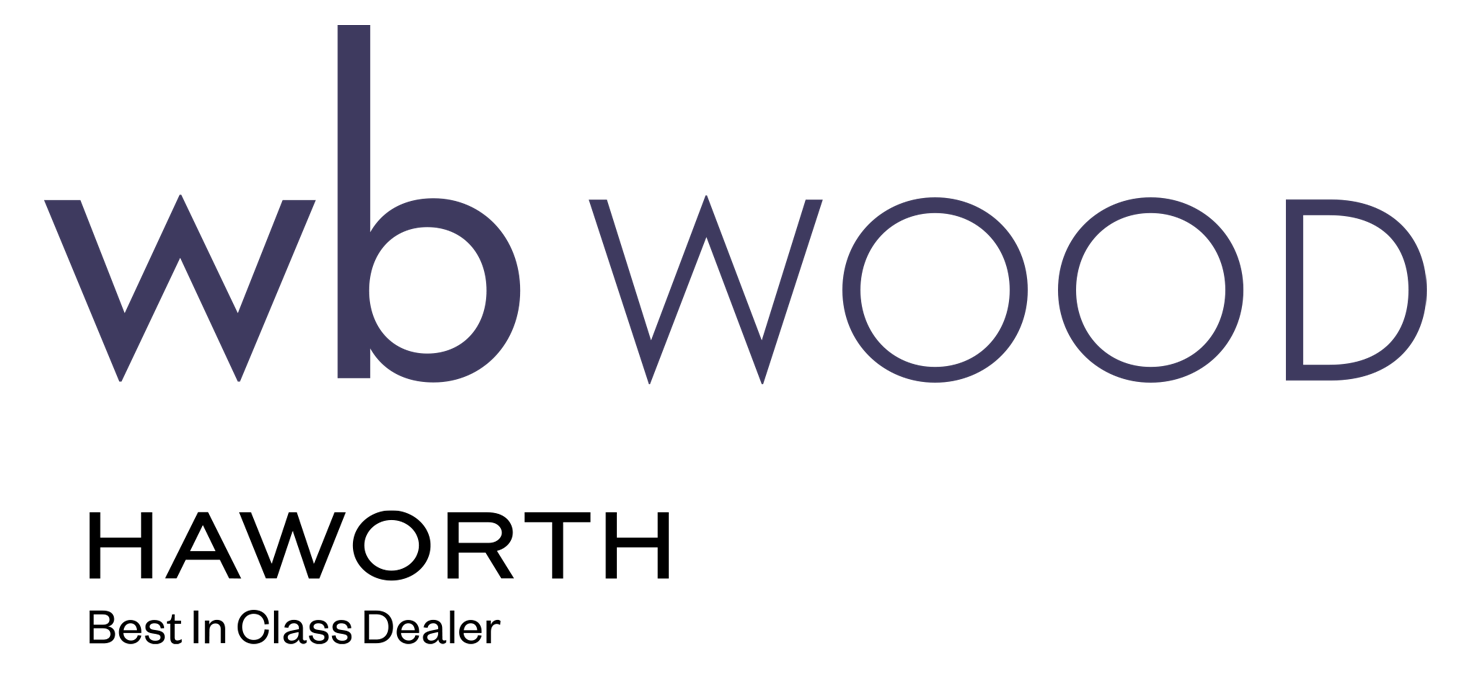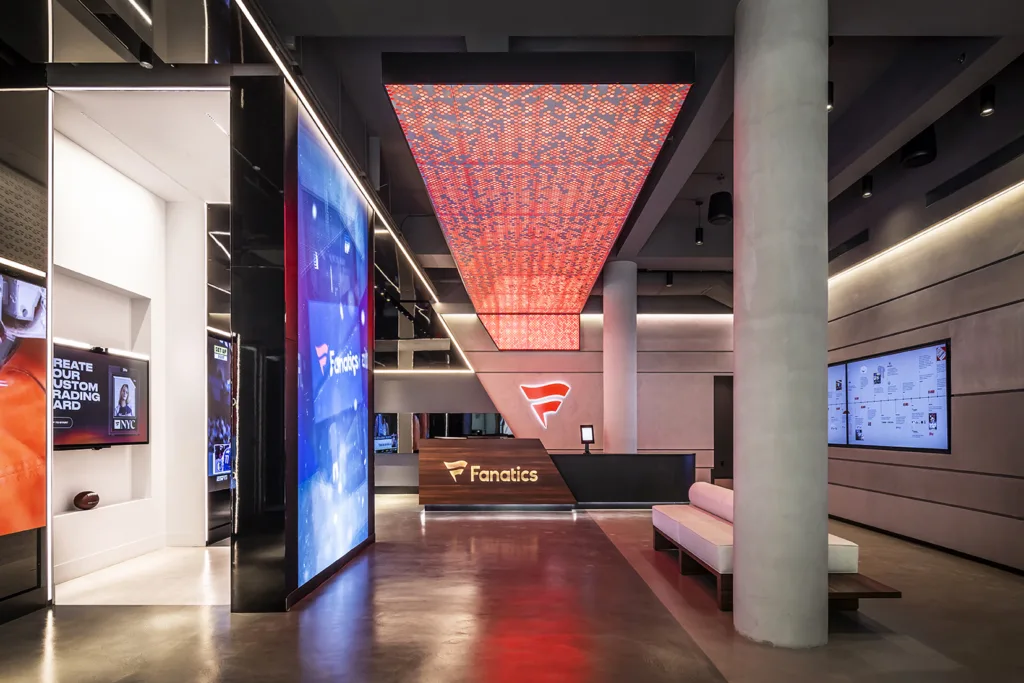The Future of Workplace Design:
Brent Capron on Evolving Design Needs and Staying Ahead of the Curve
With a focus on the future of workplace design, award-winning designer Brent Capron has transformed millions of square feet with his inspirational workspace plans. Having spent 30 years in the design industry, Brent is now the Design Director for Interiors at Corgan’s New York studio.
 Since launching his career as an architect in New York and Los Angeles, Brent has designed interiors for organizations in sectors like hospitality, healthcare and transportation. However, workplace and corporate interiors are his specialties.
Since launching his career as an architect in New York and Los Angeles, Brent has designed interiors for organizations in sectors like hospitality, healthcare and transportation. However, workplace and corporate interiors are his specialties.
Having worked with Brent on various corporate designs, we are pleased to feature him in this exclusive interview, where he delves into workspace design’s changing demands, what to expect as the future of workplace design unfolds and how to stay ahead of the curve.
The Evolution of Workspace Usage Over the Past Five Years
Since Covid-19, Brent has seen changing expectations shape the ways people interact with workspaces. He considers the pandemic the accelerator for our transformation out of the “Industrial Age” and into the “Digital Age.”
“In the Industrial Age, you had this mechanized schedule, almost like an assembly line, for how you experience space, business and the world,” Brent says. “Everything was timed, everyone was in sequence and everything was neatly organized in a certain way.”
Now, in the Digital Age, “we’re on demand, and it’s more of an organic structure.” Although many people are working in-house again, numerous workers are leveraging flexible hours to fit their careers in with their lives. As a result, the on-demand style of work is more popular than ever before.
“There’s this bell curve where fewer people are in on Monday, everybody’s in on Wednesday, and hardly anybody on Friday. It’s just the norm in New York now,” Brent says. “You can’t find a seat anymore — whereas before, you could — but now people are coming in from 8:00 to 10:00, leaving early and doing what makes sense for them.”
Embracing the Future of Workplace Design: Flexibility
It isn’t just the time we spend in workspaces that has changed. Brent explains that the designs underpinning these spaces have also shifted, bridging the way into the future of workplace design.
Before the pandemic, the criteria for many spaces was simply for them to work efficiently. However, because of the rising demand for flexible work environments, “people are now less willing to accept utilitarian spaces,” he explains.
The focus is on “drawing someone to a space, not just the scientific calculations of how the space works.”
Brent has noticed an increased demand for flexibility in the spaces he designs — but also a shift in what it means for a space to be flexible.
Flexibility “used to be about accommodating different activities within the space,” he says. “Now it’s more about the flexibility to adapt as needs change because no one can predict what kind of meetings or gatherings will be needed tomorrow.”
Alongside this flexibility, Brent notes that “variety within spaces is crucial because it speaks to neurodiversity and business changes. If today’s meetings function one way and tomorrow’s meetings need something else, the ability to change quickly is only growing in importance.”
“We’re seeing spaces designed around that need as we embrace the future of workplace design. Even post-pandemic, there’s a slight return to enclosed spaces, but now those enclosed spaces are more than just offices — they’re different types of spaces, all designed to be adaptable.”
The Importance of Sustainability in the Future of Workplace Design
Not only do modern spaces need to be flexible but they also need to be designed with wellness and sustainability at the forefront.
Historically, designers would need to tell clients about the advantages of integrating sustainability and human wellness into spaces. This is “no longer a hard sell” — and won’t be a hard sell in the future of workplace design either.
“People get it,” Brent says. “No one can argue that it’s not important at this point.” Today, the question is, to what degree should clients focus on sustainability?
Fortunately, the cost of ensuring sustainability is low, making it an easy addition to design specifications. “It’s only when you get into that top 20% or 25%, thinking about things like solar, daylight harvesting and the more extensive versions of sustainable design that the costs become significant,” Brent explains.
“For basic sustainability, like using recyclable and smart materials, not being wasteful and designing for wellness, those are becoming almost expected.”
“Sustainability and wellness will slowly become policy because people will recognize that those are basic human rights and needs in a space, and should be regulated and required,” Brent says.
Organizations are beginning to follow in the footsteps of companies like Google, Fanatics, and WestCap, creating spaces that are not only sustainable but also “fun, attractive, and part of their identity.”
“It’s not just about being green, minimal, or responsible—it’s about living the brand, turning its ethos into the everyday experience of what it feels like to work in the space.”
Google, Fanatics’ global headquarters in New York, and one of our financial clients exemplify how workplaces can go beyond function to embody the spirit of the brand itself. Google transformed the traditional office into a space that breathes innovation. Every corner sparks creativity, making work dynamic and engaging, fully aligned with Google’s ethos of exploration.
Fanatics brings the energy of sports to life in their offices, immersing employees in the thrill of the fan experience. The environment celebrates the diversity of teams, cities, and cultures, making the brand’s essence part of everyday life.
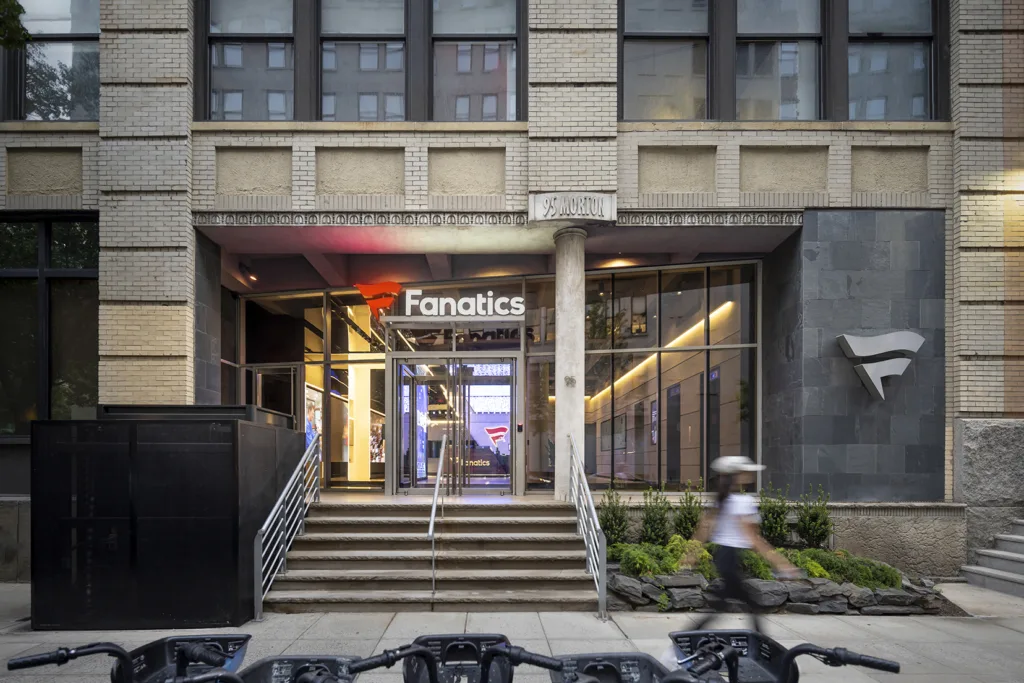
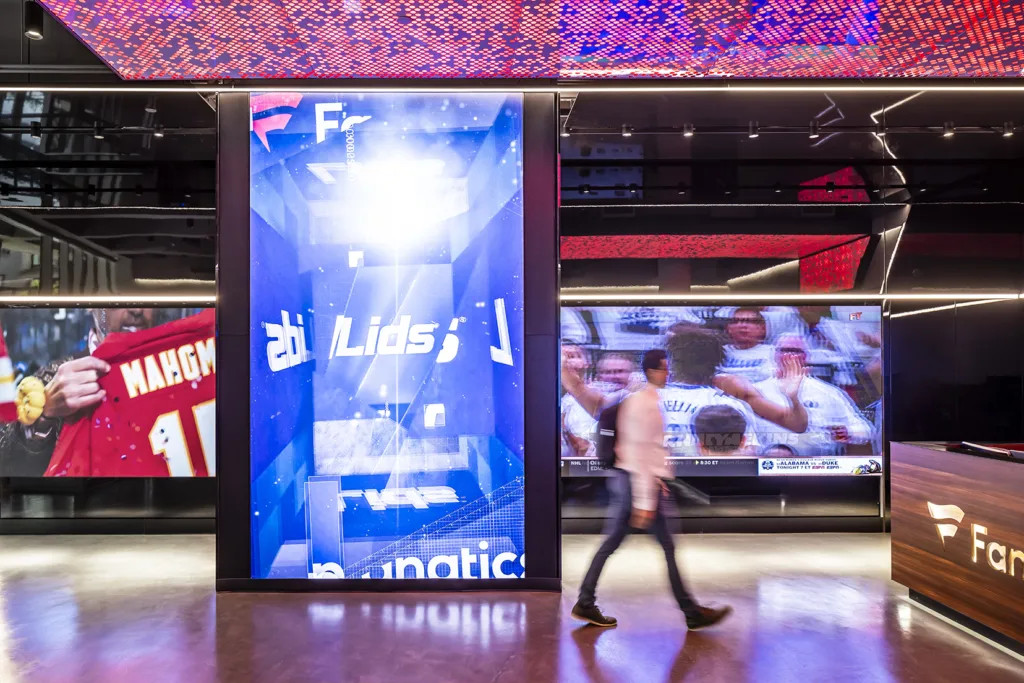
Our financial client reimagined financial spaces with a creative twist, featuring an egg-shaped collaboration room that symbolizes idea incubation. This sophisticated space breaks away from corporate norms, encouraging innovation and diverse thought.
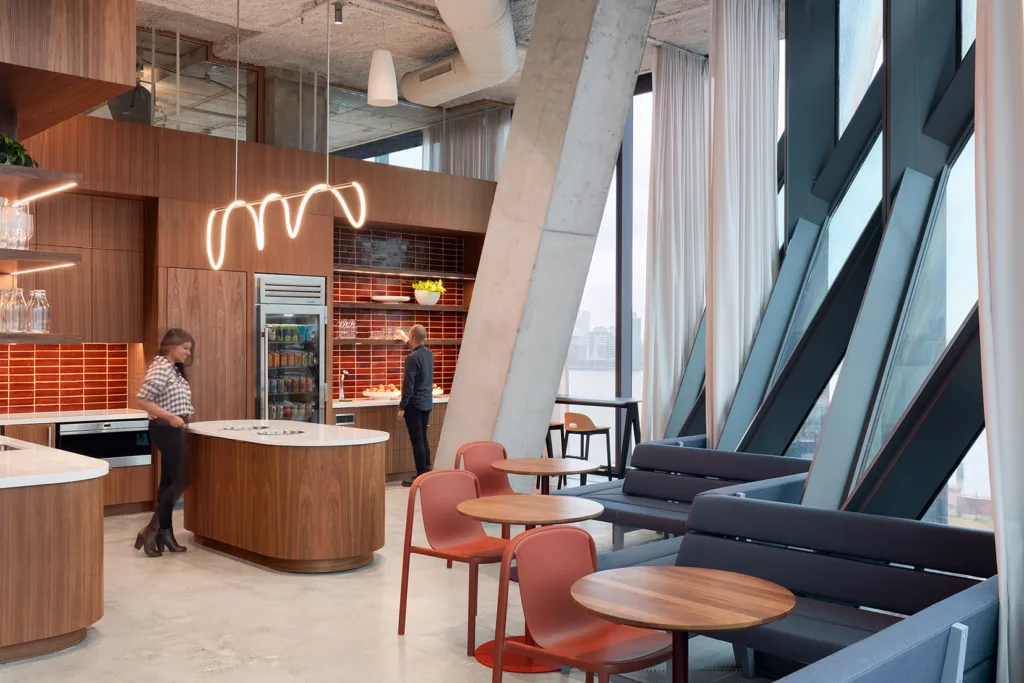
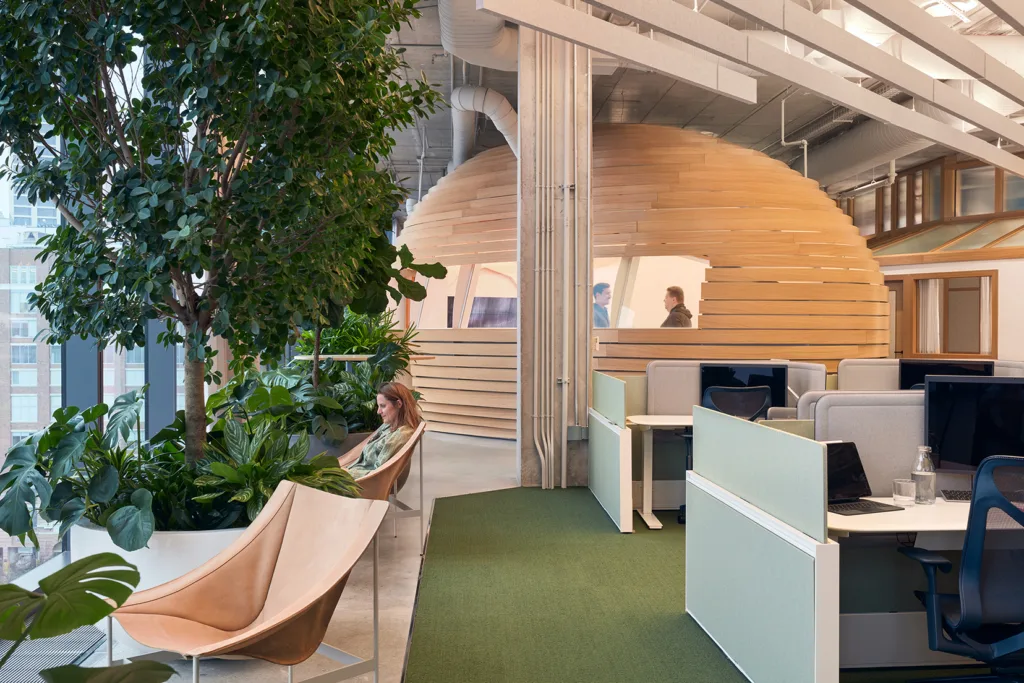
Together, these companies set a new standard—workspaces that not only function but truly embody their brand, allowing employees to live the brand every day.
“Employees are no longer cogs in the wheel from the Industrial Age,” Brent says. “We’re fully realized people with emotions and needs. How is our space part of that identity? I think that will increase.”
Advice for Those Supporting Clients in the Future of Workplace Design
As sustainability takes its place at the forefront of design across all sectors, the next generation of designers will need to guide their clients through the process of deciding which sustainable features to prioritize.
To support clients effectively, designers will need to understand exactly how bringing wellness and sustainability into design works. They will also need to speak to the benefits that will result from incorporating sustainable aspects.
With this in mind, Brent advises young designers to focus on their education and, ideally, become Leadership in Energy and Environmental Design (LEED) accredited.
The Future of Work: Technology in Workspace Design
Over the past five years, technology has played an increasingly pivotal role in design. “The ability to scan our spaces more accurately, see things more quickly and iterate more frequently is only going to increase,” Brent says. “It’s faster now; we’re probably heading toward the point where we’re creating space almost magically in front of ourselves.”
When preparing designs, Brent ideates with clients using the building information modeling (BIM) software Revit and the real-time rendering and virtual reality tool Enscape. These tools allow him to make live changes to a design during a meeting.
“What’s great about [these tools] is that they enable clients to see things more accurately. It used to be an art to sell an image and ethos, but clients often didn’t really understand what it was like until they were in the space. Now, it’s eerily accurate, even for myself,” Brent says.
He reflects on the earlier days of his career, when he’d only experience the “magical moment” of a design coming together at completion. “Now, you have that experience in the computer before you even get there,” he says. This experience is set to become even more vivid and comprehensive in the future of workplace design.
The Future of Work: AI and the Value of Human Interaction
Given the rise of technology, artificial intelligence (AI) will play a larger role than ever before in the future of workplace design. While this can be positive, as AI is helping many people create digital designs, potential clients may decide not to consult a designer.
Brent emphasizes that “the value of human interaction and the time spent thinking about design are crucial because there’s so much information out there.”
It can be challenging to sift through this information to make priorities for a design. However, a designer will guide a client to choose the right priorities for them and give them peace of mind that their design will achieve their goals.
The Future of Workplace Design: A Unicultural Vision
Beyond technology, Brent also expects that transcontinental migration will affect architecture in the future of workplace design. As the populations of the U.S. and Europe increase and the world “shrinks,” he believes we will see an increasingly blended mixture of cultures.
“It’s not so much multicultural as it is unicultural,” he says. “It will be interesting to see how our spaces adapt to that… We might see less differentiation between architectural styles because digitization could lead us to a more homogenized human experience in the built environment.”
“The differences between cultures could become less pronounced as we’re influenced by global styles, not just physical but digital. The ability for space to adapt and accommodate that will be fascinating.”
Staying Ahead of the Curve When Innovating as a Designer
Brent finds it easier to innovate on designs when he has the context to plan a truly unique space for a client. To plot a design that stays ahead of the curve, he asks clients the following questions that dive into their deeper visions:
- Is this project about repositioning your brand?
- Are you looking to repair, change or create something entirely new?
- Is the project driven by a need for greater efficiency or enhancing happiness?
- What are your goals, and why are you investing in this?
Asking questions like these is important because clients may not always be able to translate their needs into a design specification. “We’re able to ask deeper questions and interpret much more accurately,” Brent says. “What are you really trying to do? Is it about connection? Speed to market? Human wellness? Growth?”
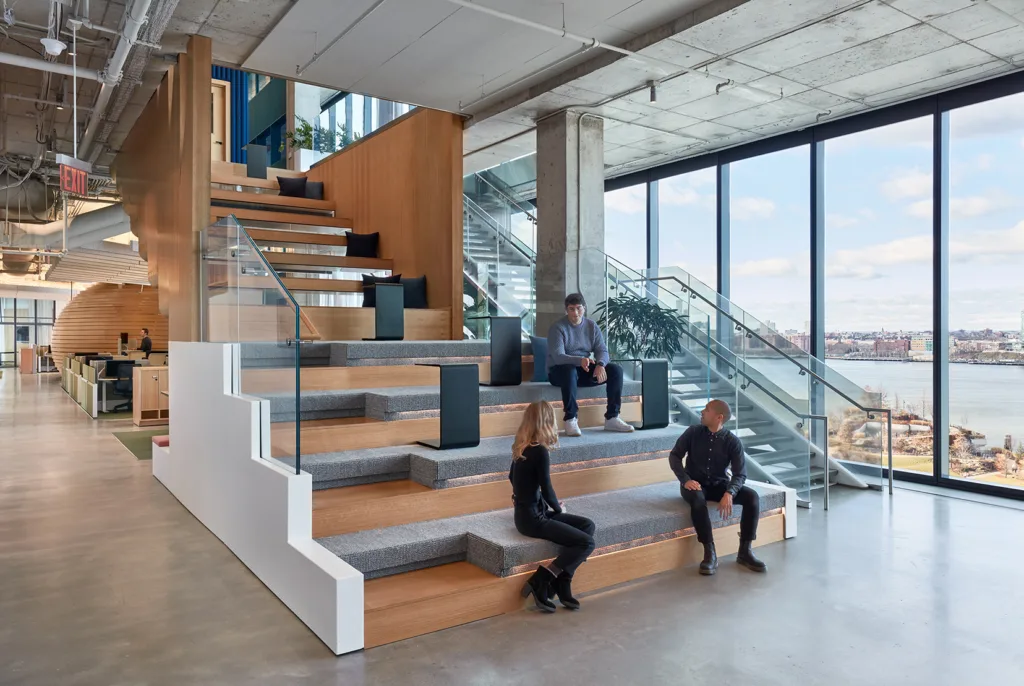
Answers to these questions help Brent understand what a client’s priorities are when every aspect of a project is important. This is vital in a world where many clients draw their inspiration from social media and may not have explored their vision beyond the aesthetics.
“There used to be a time when you could identify designers more easily, but now, with all the available inspiration and iterations from platforms like Pinterest, we have to make sure we’re pulling back and being brave,” Brent says.
“You’re bringing in outside influences, not just other architects. You must make sure you’re innovating, not iterating.”
Brent and his team also “do a lot of persona tracing to understand the different personas that will experience the space and when,” he explains. “It’s been more important to see the true end goal of the client and what they are trying to achieve.”
Designing a Journey, Not an End Result
With this approach, each client enjoys a unique “process and journey, not just an end result,” Brent says. As a consultant, he will take a client from knowing they want “something specific” to understanding “what they truly need.”
“It takes time, and you build confidence in the client along the way to help them feel courageous enough to pursue innovative directions,” he says. “Otherwise, everything becomes vanilla, and it could be anywhere, for anyone.”
This is especially important when designing for the public, as such a project “needs to speak to a culture, not just a single client.”
Human-Centric Design Considerations
Human-centric design is also key to unique innovations and will continue to be essential in the future of workplace design. Although this kind of design has been important in Brent’s work for years, he explains that this now “feels fresh because we’re more educated on it. We now have ways to measure and record it.”
Human-centric design is crucial because it’s about “recognizing that not all humans are the same, and finding which personas are most applicable to the purpose you’re designing for.”
Brent also notes that age diversity is an important consideration for designers. “At Corgan, we have a “suit” that simulates aging by blurring vision and impeding movement,” he says. “Our teams use it to evaluate design for the elderly in settings such as airports — that recognition of diversity extends into all aspects of design now.”
How Brent Stays Creative as a Designer
Brent’s secret to staying creative is to pursue an outlet outside of design. For him, this is usually singing in a choir, which allows him to “engage with the world in a different way.” He also found a creative outlet in workshopping a friend’s opera. This “completely changed my perspective when I returned to work,” he says.
A creative outlet could be anything you like, perhaps “building a birdhouse, learning a language or volunteering,” Brent says. “It’s about putting yourself in an unfamiliar environment. The process of moving from uncomfortable to comfortable is where new learning happens.”
“It’s all about breaking routine and refreshing your mind.” When you switch to a new creative activity or challenge, you “adapt your ability to learn,” which “keeps you sharp.”
Brent’s Closing Advice: Keep Waking Yourself Up
As a closing note, Brent reminds designers that “even if something is going well,” it’s important to “constantly evaluate your processes and thoughts” and to “challenge yourself to avoid becoming complacent.”
“Success can be positive,” he says, “but you have to remind yourself to keep challenging yourself because the world is changing, and you don’t want to be left behind.”
“Keep waking yourself up. You’re never going to reach a point where you’ve made it. The journey continues, so keep your eyes open, ask questions and challenge yourself. If you don’t feel challenged, find ways to make yourself challenged because that’s when the best work happens.”
The Future of Workplace Design: Creating Meaningful Spaces
WB Wood partners with designers like Brent who create meaningful, future-proofed spaces. These spaces promote well-being, meet sustainability criteria, inspire emotional connection and deliver on a client’s vision.
Take a look at our corporate workspace projects.
Contact WB Wood at https://wbwood.com/contact/.
